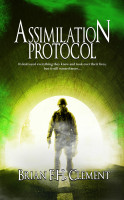
Assimilation Protocol by Brian F.H. Clement
Damnation Books, 2017
ISBN: 978-0-9950790-2-1
Available: Multiformat ebook, via Smashwords
Assimilation Protocol is the sequel to Brian Clement’s novel The Final Transmission (Damnation Books, 2013). The Final Transmission was reviewed and recommended by The Monster Librarian in 2015. Clement weaves elements of crime mystery, post-apocalyptic science fiction, and horror into both novels. Although Assimilation Protocol can be read alone, it is best read together with the first novel. Some of its characters continue from the first novel, and the plot of the second book is best understood as the struggle between the forces revealed at the end of the first novel.
In Clement’s first novel, set in the 13th century, a French knight returns from the Crusade and stumbles across an orgy. Mistaking the celebrants’ sexual frenzy as part of a heretical religion, he slaughters all the men and women. In reality, the victims are members of the Children of the Ninth Darkness. With incantations and human sacrifice, the cult summons an extraterrestrial force that they call the Olog’lahai’kuhul. Its purpose is to seed the universe with microscopic organisms called zooids. On Earth, zooids infect humans, melding together human, animal and plant cells. The resulting mutants are chimeras that mix the appearance and capabilities of the organisms. The knight and his followers form another clandestine group called the Ordo Sanctus. Its members seek to destroy the Children and use the zooids to gain power for themselves.
Eight hundred years later, an introverted police detective in Toronto and his research assistant discover that a series of disappearances and murders are human sacrifices by the Children of the Ninth Darkness. The sacrifices create deadly mutants that can rapidly self-replicate. Meanwhile, the Ordo Sanctus has developed into a worldwide cabal that controls biotech and pharmaceutical companies and private armies, and has infiltrated the Toronto police. Their most powerful weapon is an indestructible cyborg, called the Cleaner. The Cleaner stalks and eliminates members of the Children and other threats to the Ordo’s plan. The Ordo succeeds in almost eradicating the Children in Toronto, and creates its own zooids, which generate mutants or kill humans. The Ordo plans to disperse these zooids in aerial canisters, stored in a warehouse. The detective inadvertently causes a warehouse explosion that spreads zooids throughout the city. Much of Toronto burns, and many of its inhabitants are either incinerated, killed by the Ordo’s mutants, or transformed into mutants themselves.
In Clement’s second novel, the Ordo Sanctus’ plan is almost complete. Worldwide, cities are ruined after 20 years of civil war and famine. Survivors form groups of humans and mutants, most of whom struggle to survive in crumbling sections of the cities. The Ordo is now the Ordex. It controls most of Toronto’s infrastructure, business and government. The Ordex’s power and control reside in the city center, in a massive, sentient computer made of organic tissue and electronics. The Ordex’s biotech company has developed cybernetic brain implants that allow humans and mutants to communicate almost telepathically with each other and with the computer network. The Ordex’s hive-brain surveils these communications.
Thomas is the last resident of an orphanage in the Toronto suburbs. He was brought there as a child 20 years ago, by a small splinter group of Ordo Sanctus members who secretly oppose the Ordex’s plan for world domination. Thomas is not a mutant, but has a special ability to intuit other peoples’ intentions. The orphanage is closing, and for the first time, Thomas must seek shelter and work outside. He wanders through the suburbs and meets gangs of humans and a menagerie of mutants with varying degrees of sentience and language. Thomas’ bag of belongings contains a copy of the Encyclopedia Nefastus, a book of forbidden knowledge transcribed from the writings of the Children of the Ninth Darkness by the crazed French knight who slaughtered them. Unknown to Thomas, he and the Encyclopedia are sought by the Ordex, the Children of the Ninth Darkness, and the Ordex splinter group who hope to use Thomas and the book to achieve their goals.
Thomas meets Ren, a human-salamander chimera, who has martial arts abilities. Together they travel through dangerous enclaves of mutants and outlaw gangs of humans, through a toxic zone where Ordex has dumped chemical wastes, and underground warrens of mutants and humans live in abandoned subway and sewer tunnels. The Ordo Sanctus’ Cleaner survived the explosion, and is buried in a graveyard. Resurrected, it continues its last mission to track down Thomas and the Encyclopedia. The Ordex sends murderous mutants, including a walking, poisonous, giant fungus and a cyborg bio-unit with a myriad of powerful tentacles hidden in a biohazard suit, to track down Thomas and his book. Thomas, Ren and members of the splinter group must somehow defeat everyone and everything hunting them, infiltrate the city center, and destroy the hive-brain.
Although Clement has several plot lines that interweave throughout the two books, they are fast-paced, coherent and move toward a satisfying finale. The characters are well-drawn, clearly displaying qualities of bravery, loyalty, determination, greed, cunning, viciousness or bloodthirstiness. Some characters are in both novels, but main characters that are only in one novel have connections that are not revealed until the denouement. Clement was a filmmaker and screenwriter before becoming an author. His ability to create vivid and dramatic scenes reflects this experience. Highly recommended
Contains: gore, violence
Reviewed by Robert D. Yee







Follow Us!